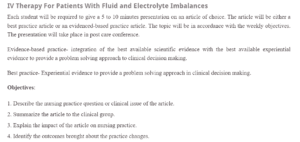Therapy For Patients With Fluid and Electrolyte Imbalances
This article explains intravenous fluid administration in patients with fluid and electrolyte imbalances. Intravenous fluids are categorized into two categories; crystalloids and colloids (Elbaih et al., 2020). Crystalloids are fluids with electrolytes such as normal saline, lactate ringers, and dextrose in normal saline. Fluid administration is determined by the tonicity state of the patient and that of the fluid. Fluids can be isotonic, hypotonic, and hypertonic.
Impact of the Article on Nursing Practice
This article is important in nursing practice because it gives practitioners a better understanding of the principles and aims of intravenous fluids. The article describes different indications of fluid administration and different types of fluids. Fluids are administered depending on their tonicity state (Elbaih et al., 2020). For example, patients suffering from dehydration are in a hypertonic state. Therefore, they need fluids in a hypotonic state to achieve the isotonic state of the body. The article explains the signs and symptoms that nurses should observe before and during fluid administration.
Outcomes Brought About By the Changes
There is improved performance of the nurses and patient safety. Through the study, nurses have gained more knowledge and skills, leading to a good prognosis, reduced complications associated with fluid administration, and reduced mortality rate. The article has improved the attitudes of the nurse toward patients with electrolytes and fluid imbalances. Nurses have become more observant of the symptoms of the patients before fluid administration. For instance, a patient with hypotension is eager to check for electrolyte imbalances before administering normal saline.
My Opinion about the Article to the Clinical Group
The article is an eye-opener to all healthcare providers. The article describes the physiology behind the electrolyte imbalances that enable nurses to make the right decision when administering intravenous fluids.
References
Elbaih, M. T., & Ismail, A. H. (2020) Electrolyte imbalances and intravenous fluid therapy critical care and emergency Medicine
ORDER A PLAGIARISM-FREE PAPER HERE
We’ll write everything from scratch
Question
IV Therapy For Patients With Fluid and Electrolyte Imbalances
Each student will be required to give a 5 to 10-minute presentation on an article of choice. The article will be either a best-practice article or an evidence-based practice article. The topic will be in accordance with the weekly objectives. The presentation will take place at a post-care conference.

IV Therapy For Patients With Fluid and Electrolyte Imbalances
Evidence-based practice- integration of the best available scientific evidence with the best available experiential evidence to provide a problem-solving approach to clinical decision-making.
Best practice- Experiential evidence to provide a problem-solving approach in clinical decision-making.
Objectives:
- Describe the nursing practice question or clinical issue of the article.
- Summarize the article to the clinical group.
- Explain the impact of the article on nursing practice.
- Identify the outcomes brought about by the practice changes.
- Give your opinion about the article to the clinical group.
ANSWER QUESTIONS # 3, 4, 5 BASED ON THE ARTICLE THAT IS ATTACHED ONLY. THE QUESTIONS ARE ATTACHED ON THE OTHER ATTACHMENT

